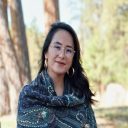Girls are transforming policies and systems, responding to emergencies, leading movements, and sparking change across the world. They are fighting against femicides in Ecuador, demanding accountability for the killing of Mahsa Amani in Iran, building a national movement where “the climate solutions used by one woman in her household can be upscaled to benefit many others” in Uganda, and driving critical action and resources to ensure access to safe drinking water in the United States and much more.
Yet, their stories and strategies of resistance are often ignored, co-opted, and severely underfunded. All of which is directly impacting their livelihood and wellbeing, and further marginalizing them.
“I wish for a world where we don’t struggle so much for basic rights. For every person, every girl to be able to decide for themselves. For the state and the church to stop treating us and our bodies as properties. For our choices to be respected.” – Kamila, Poland, Stories of Girls’ Resistance Storyteller
Locating girls in the funding stream
Launched earlier this year, Resourcing Girls to Thrive highlights that while many actors recognize the significance of supporting girls, only a few are translating that recognition into concrete actions or practices that effectively allocate resources that support girls’ political agency. When analyzing funding streams, girls tend to be lumped in with other groups so their unique needs are not met, or the lack of an explicit focus results in their exclusion. Despite their critical role in advancing social justice movements, girls are rarely resourced in movement-focused funding streams. Funding streams that do include girls are so often siloed, not recognizing that girls are entitled to their full human rights, such as bodily autonomy and access to education, health care, and clean water, not sequentially but simultaneously.
We have the evidence, but the question remains: where is the money?
Funders often rely on quantitative evidence to guide funding strategies over recognizing girls’ experiences and stories as evidence. Many argue there is not enough evidence demonstrating the impact of girls’ work and activism. The recently launched Stories of Girls’ Resistance tells us otherwise. Drawing from feminist knowledge across communities and eras, this research provides a robust body of evidence demonstrating the multiple ways girls are resisting: transforming their homes, communities, and the world.
And, while we know this impactful work is happening in every corner of the world, it often looks radically different from the popular narratives and lives outside the existing frameworks that drive funding decisions. Through the analysis of the Stories of Girls’ Resistance and Resourcing Girls to Thrive, it is evident that dominant narratives surrounding girls, and the funding practices, programs, and policies that shape their environment and context, often disconnect girls from each other and disregard their social and political context. These narratives perpetuate the misconception that they are only beneficiaries and not political actors. Solely identifying funding for ‘girls’ without considering their broader political and social justice efforts presupposes a fixed identity for girls that fails to reflect reality, but instead mirrors the confining structures imposed by the system.
Girls’ are not only imagining a world of freedom, they are creating it through bold, creative, and sharp tactics and strategies: if funders follow girls’ lead, we all win.
“Solidarity is Imagining freedom together. It might just be an experiment. But at least if we start it, maybe someone else will continue it.”
Zemdema, Ethiopia, Stories of Girls’ Resistance Storyteller
How can we seed a world where girls can thrive?
By moving towards a practice-oriented, ecosystem approach to resourcing girls – one that centers girls’ political agency, builds solidarity among girls, and pursues strategies for transformation – we can build a world where girls can thrive.
Girls want a world where they have power, freedom, success, protection, safety, a strong cultural identity, confidence, love, and joy. – Girl Research Contributors, Resourcing Girls to Thrive
Here are five concrete recommendations to this end:
- Locate girls across your movement and strategies. Girlhood is not a static or singular identity and girls organize across multiple issues. There is not a singular, cohesive girls’ movement or field to fund. Instead, look within your movement, sector, portfolio, and program to locate girls. Fund the work they are doing – it connects with every single issue.
- Move more resources to girls. Determine your unique role within a larger funding ecosystem and the best way for you to move money. If you can fund larger institutions, fund organizations that hold deep expertise in moving resources directly to locally led, politicized work with girls among public foundations, feminist funds, youth funds, and re-granters. If you can fund local organizations directly, resource them directly.
- Start learning while continuing to fund. If your funding overlooks girls’ political agency, begin to change your practices – not abruptly, but start learning. Partner with experienced organizations that center girls’ political agency, look for co-funding opportunities, join funder collaboratives, engage accompaniment services, and invest in internal learning exchanges.
- Build relationships and foster connections: Build relationships with people across the girls’ ecosystem and get to know a diverse range of actors. Ask your current partners how they are centering girls in their work and if they are not, encourage them to start identifying and connecting with girls in their movements. If they are, learn more about how and learn alongside them.
- A diversity of approaches are required. Approaches directly depend on an institution’s size, proximity to girls and their allies, grantmaking processes, and decision-making structures. While participatory decision-making processes may work for some, they can be harmful when replicated by others. Explore different approaches.
Recognizing girls’ political agency in funding flows requires practice change and money – not more evidence. A funding ecosystem where girls can thrive requires multiple perspectives, entry points, and modalities. With a funding ecosystem where girls thrive, we all thrive. We invite funders who are committed to seeding a new kind of world, one that is grounded in equity, freedom, and justice to join this journey with us, to learn, explore, and experiment. Stop looking for evidence, as an abundance already exists, and start moving money to girls’ organizing and activism.
“Sometimes seemingly small acts of resistance work to transform her world, and often plant and nourish the seeds for decades of resistance to come.”
~ Stories of Girls’ Resistance
Authors
This article was co-written by Angelika Arutyunova, Amy Babchek, Jody Myrum, and Laura Vergara of Our Collective Practice







Comments (0)